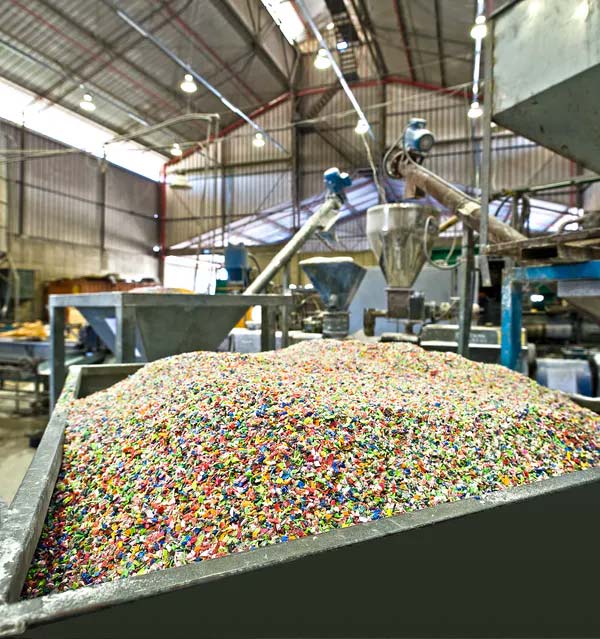Chemical recycling can be a solution to the problem of plastic waste pollution
It is no exaggeration to say that the Earth is engulfed in plastic. According to statistics, about 60% of the more than 8,700 million tons of plastic that have been produced by humans in the past decades has been no longer usable, but instead they are mainly located in landfills or have been discharged into the environment. This is equivalent to the fact that each of the 7.6 billion people on the planet are carrying nearly 400kg of plastic waste on their backs.
One of the main causes of this problem is that most plastic waste takes hundreds or thousands of years to decompose in natural conditions. Besides, there are weaknesses in waste separation and recycling processes, while the demand for plastic is constantly increasing.
Plastics cannot be recycled indefinitely, at least for traditional techniques. Most can only be reused a few times before being thrown into the environment or gathered in incinerators. However, there is a newly introduced method that can help solve this problem, namely 'chemical recycling'.
Traditional physical or mechanical recycling methods often grind the plastic into granules, tiny pieces, then mix and cast them together to create lower-grade plastic products. However, chemical recycling aims to break down plastic components at the molecular level, create available molecular molecules, and then reuse them to make other materials with a quality that is not be reduced. This is a refreshing way, requiring a high level of technology as well as a more complex machine system than the current methods. But if applied successfully on a large scale, the problem of plastic waste recycling will become much less difficult.
 Plastic is crushed for recycling
Plastic is crushed for recycling Basically, plastic is a similar name for polymer materials, made up of small monomers made of carbon and hydrogen. The biggest challenge in the chemical recycling process lies in how to find the right techniques to break down and recreate this material into a variety of high quality products, while the waste is still guaranteed. Maximum protection. All needs to be done effectively, economically, on a large scale and in carbon neutral.
The monomers that make up plastic can come in many shapes and sizes: straight lines, branches or rings. The way they are linked together is a factor that helps determine the properties of plastic materials, related to the way of breaking topology, melting temperature .
Plastics are very stable materials, so a large amount of heat is needed to break down their molecular structure, in a process called pyrolysis.
However, suitable catalysts can also be used, causing chemical reactions from a specific position in the polymer chain. An example of a catalyst is a type of biological molecule called an enzyme. Enzymes are found in living organisms and play an important part in digestion. Up to 50 types of plastivore microorganisms contain enzymes that can digest plastic by causing chemical reactions at the molecular level. Other catalysts, such as iron nanoparticles, turn black plastic (one of the most difficult to recycle) into carbon nanotubes in a short time.
Currently, most chemical recycling processes for plastic waste take place only on a laboratory scale. However, there have been many projects currently being implemented at the commercial level. These processes require a lot of time, expertise and money, but if successfully applied on a large scale, the benefits they bring to the natural environment and life on the planet are 'invaluable. '.
You should read it
- How are people using plastic to destroy nature?
- Manufacturing electric cables from plastic waste - The great plan for the situation of plastic waste pollution in the world today
- What is ABS plastic? Applications of ABS plastic in life
- The Earth has more than 8 billion tons of plastic, weighing about 1 billion elephants
- How long does it take waste to decompose?
- Microplastics discovered in an 11-year-old ice core in Antarctica
- How dangerous chemicals are in plastic consumer products
- What is PP plastic? These products are manufactured from PP plastic
- Scientists created a mutant enzyme that 'ate' nearly a ton of plastic bottles after a few hours
- The AI system helps detect plastic waste in the ocean through satellite images
- Things to know when using food plastic
- Tools that turn plastic bottles into ropes
May be interested

Robots can recharge themselves by 'eating metal'

Apple's new initiative could stop screen peeping

Samsung's new battery technology can allow electric cars to run up to 800km on a single charge

Why do beautiful natural photos make people feel happy?

Baidu develops open source AI to identify people who do not wear masks

Artificial neurons have been able to communicate with biological neurons via the Internet






 Manufacturing electric cables from plastic waste - The great plan for the situation of plastic waste pollution in the world today
Manufacturing electric cables from plastic waste - The great plan for the situation of plastic waste pollution in the world today How are people using plastic to destroy nature?
How are people using plastic to destroy nature? The truth about recycling e-waste and its effectiveness
The truth about recycling e-waste and its effectiveness Examine the process of turning garbage into street bricks and clothes in Japan
Examine the process of turning garbage into street bricks and clothes in Japan Finding two breakthrough solutions in plastic waste treatment
Finding two breakthrough solutions in plastic waste treatment How long does it take waste to decompose?
How long does it take waste to decompose?